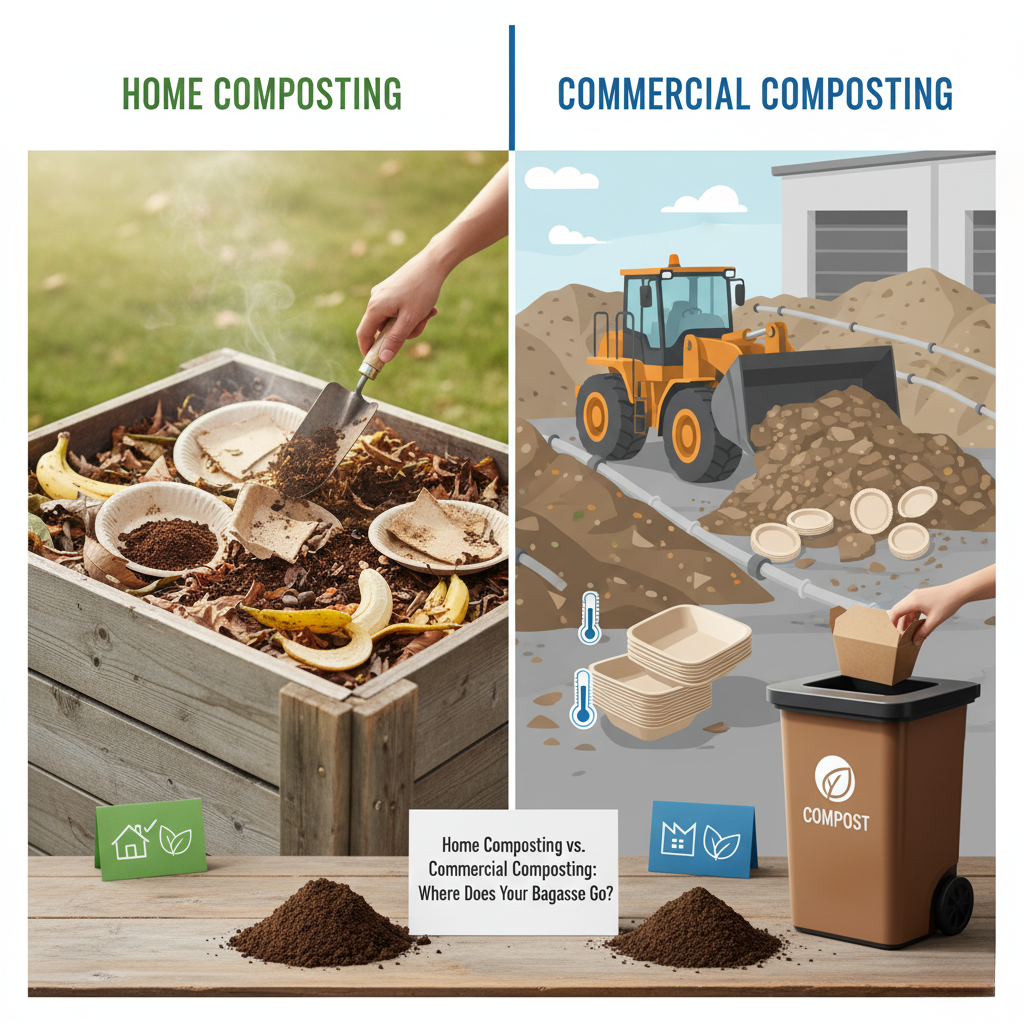
Home Composting vs. Commercial Composting: Where Does Your Bagasse Go?
Share
You've made the smart switch to sugarcane bagasse tableware – fantastic! You're actively choosing products that reduce plastic waste and support a circular economy. But now comes the next crucial step: proper disposal.
Understanding the difference between home composting and commercial composting is key to ensuring your bagasse plates, bowls, and containers truly break down and fulfill their eco-promise. Without the right conditions, even the most sustainable products can end up taking up space in a landfill.
Let's clarify where your bagasse goes to become nutrient-rich soil.
1. The Basics of Composting: Nature's Recycling System
Composting is a natural process where organic materials decompose under controlled conditions to create nutrient-rich soil amendment, known as compost. It relies on a delicate balance of:
- "Greens" (Nitrogen-rich): Food scraps, grass clippings.
- "Browns" (Carbon-rich): Dry leaves, wood chips, and materials like bagasse.
- Moisture: Like a wrung-out sponge.
- Oxygen: Needs to be turned regularly.
- Microbes: The tiny workers (bacteria, fungi) that break everything down.
The primary difference between home and commercial composting lies in how these conditions are managed and on what scale.
2. Home Composting: The Backyard Hero
What it is: This is the composting you do in your own backyard bin, pile, or worm farm. It's a fantastic way to manage kitchen scraps and garden waste, creating valuable compost for your own plants.
How it works: Home compost piles typically operate at lower, less consistent temperatures than commercial facilities. The decomposition process is slower, and the conditions (like aeration and moisture) can vary depending on how actively the pile is managed.
Can Bagasse Go Here?
- YES, USUALLY! Many sugarcane bagasse products are designed to be home compostable. Look for specific certifications or clear labeling from your product supplier.
- Expect a Slower Process: Because home compost piles are cooler and less intensely managed, a bagasse plate will take longer to break down (e.g., several months to a year) compared to the rapid breakdown in a commercial facility. It might also require you to tear the items into smaller pieces to speed up decomposition.
- What to Look For: Items like pure, uncoated bagasse plates, bowls, and simple containers are generally good candidates. Be wary of any bagasse items with noticeable coatings, as these might require commercial processing.
Benefits of Home Composting Bagasse:
- Convenience: Dispose of your eco-friendly disposables directly in your garden.
- Creates Your Own Soil: Get free, nutrient-rich compost for your plants and garden beds.
- Full Control: You see the entire decomposition process firsthand.
Limitations of Home Composting Bagasse:
- Slower Breakdown: Takes longer than commercial facilities.
- Space & Management: Requires dedicated space and regular turning/maintenance of the pile.
- Not for All "Compostable" Items: Some items labelled "compostable" (like certain bioplastics) are only suitable for commercial facilities due to their specific breakdown requirements.
3. Commercial Composting: The Industrial Powerhouse
What it is: Large-scale industrial facilities that process huge volumes of organic waste from homes, businesses, and municipalities. These facilities are designed for efficiency and speed.
How it works: Commercial composters use specialized equipment to create and maintain optimal conditions for rapid decomposition. This includes:
- High Temperatures: Piles reach and sustain temperatures often exceeding 140°F (60°C), which effectively breaks down materials and kills pathogens and weed seeds.
- Consistent Aeration: Regular turning and forced air systems ensure optimal oxygen levels.
- Precise Moisture Control: Water is added as needed to maintain ideal moisture.
- Grinding & Shredding: Materials are often shredded to increase surface area for microbial activity.
Can Bagasse Go Here?
- ABSOLUTELY, AND THIS IS WHERE IT SHINES! All certified compostable bagasse packaging is designed to break down efficiently in commercial facilities.
- Rapid Decomposition: Your bagasse items will typically break down completely within 60-90 days, returning to earth as valuable soil.
- Ideal for Businesses: Restaurants, cafes, and event venues can send their food scraps along with compostable catering supplies to these facilities, significantly diverting waste from landfills.
Benefits of Commercial Composting Bagasse:
- Guaranteed Breakdown: Optimized conditions ensure complete and rapid decomposition.
- Convenient for Businesses: Can handle large volumes of organic waste, including food-soiled packaging.
- Wider Acceptance: Can process a broader range of "compostable" products, including those that are only commercially compostable.
Limitations of Commercial Composting Bagasse:
- Accessibility: Not all municipalities have accessible commercial composting services. Check with your local waste management provider.
- Contamination Risk: If non-compostable items (like plastics) are mixed in, they can contaminate the entire batch.
Making the Right Choice for Your Bagasse
To ensure your eco-friendly disposables truly fulfill their purpose:
- Check Labels & Certifications: Look for clear "home compostable" or "commercially compostable" labels, often accompanied by certifications like BPI or Seedling.
- Know Your Local Services: Research what composting services are available in your area, both curbside and drop-off options.
- Educate Yourself & Others: Understand what goes into each type of compost. When in doubt, it's safer to send commercially compostable items to an industrial facility if available.
By understanding the journey your bagasse takes, you empower yourself to make the best disposal decisions, closing the loop on your sustainable choices and genuinely contributing to a healthier planet.
